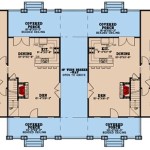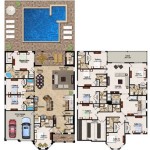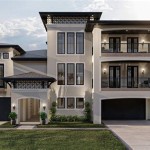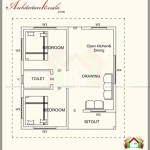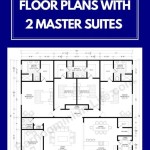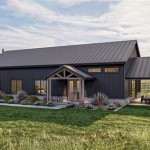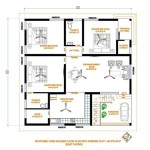```xml
One level ranch home plans, also known as rambler style homes, represent a popular choice for homeowners seeking simplified living, accessibility, and a timeless aesthetic. These designs are characterized by their single-story construction, elongated floor plans, and often, attached garages. The enduring appeal of ranch homes stems from their practicality, versatility, and adaptability to various lifestyles. This article provides a detailed exploration of one level ranch home plans, covering their history, key features, benefits, considerations, and variations to help prospective homeowners make informed decisions. The ranch home style originated in California during the 1930s, drawing inspiration from Spanish Colonial architecture. Architect Cliff May is often credited as a key figure in popularizing the design. Early ranch homes emphasized natural materials, open floor plans, and integration with the surrounding landscape. Following World War II, the ranch style experienced a surge in popularity as housing demand increased and suburban developments expanded. These post-war ranch homes were often more standardized and affordable, catering to the needs of growing families. Over the decades, ranch home designs have evolved to incorporate modern amenities and architectural trends. Variations include split-level ranch homes, raised ranch homes, and contemporary ranch designs with updated materials and layouts. Despite these modifications, the fundamental characteristics of a single-story layout and emphasis on informal living spaces remain central to the ranch style. One level ranch home plans are distinguished by several defining features that contribute to their unique character and functionality. These include: Single-Story Construction: The most prominent feature is the absence of stairs, making ranch homes ideal for individuals with mobility limitations, families with young children, and those seeking aging-in-place solutions. This design eliminates the need to navigate multiple floors, promoting safety and convenience. Low-Pitched Roof: Ranch homes typically feature a low-pitched roofline, often with wide eaves that provide shade and protect the exterior walls from the elements. The roof design can vary, including gable roofs, hip roofs, and shed roofs, depending on the specific architectural style and regional preferences. Open Floor Plans: Many ranch homes incorporate open floor plans that seamlessly connect the living room, dining area, and kitchen. This design promotes social interaction, facilitates natural light flow, and creates a sense of spaciousness. Open floor plans are particularly well-suited for entertaining and family gatherings. Large Windows and Sliding Glass Doors: Ranch homes often feature large windows and sliding glass doors that provide ample natural light and connect the interior spaces with the outdoors. These features enhance the visual appeal of the home and allow residents to enjoy views of the surrounding landscape. Attached Garages: Attached garages are a common feature of ranch homes, providing convenient access to the house and protecting vehicles from the weather. In many cases, the garage is located on the same level as the living spaces, further enhancing accessibility. Horizontal Emphasis: Ranch homes tend to emphasize horizontal lines, creating a sense of groundedness and stability. This is achieved through the elongated floor plan, low roofline, and horizontal siding materials. Simple and Functional Layouts: Ranch home plans typically prioritize functionality and efficient use of space. The layouts are often straightforward and easy to navigate, with clear separation between living areas, bedrooms, and utility spaces. Selecting a one level ranch home plan offers numerous advantages for homeowners, including: Accessibility and Aging-in-Place: The absence of stairs makes ranch homes ideal for individuals with mobility limitations and those planning to age in place. This feature eliminates the risk of falls and allows residents to remain in their homes comfortably and safely as they age. Easy Maintenance: Single-story construction simplifies home maintenance tasks, such as roof repairs, gutter cleaning, and exterior painting. All areas of the house are easily accessible without the need for ladders or scaffolding. Reduced Heating and Cooling Costs: Ranch homes often have lower ceilings and better insulation compared to multi-story homes, which can result in reduced heating and cooling costs. The single-story design minimizes heat loss through the roof and walls. Enhanced Safety During Emergencies: In the event of a fire or other emergency, ranch homes offer easier and faster egress compared to multi-story homes. All occupants can quickly evacuate the house through ground-level doors and windows. Versatile Design Options: Ranch home plans can be customized to suit a variety of lifestyles and preferences. The open floor plans and flexible layouts allow for easy modification and adaptation to changing needs. Additions, such as sunrooms, patios, and decks, can be seamlessly integrated into the design. Strong Resale Value: Ranch homes remain a popular choice among homebuyers, ensuring a strong resale value. The timeless appeal of the ranch style, combined with its accessibility and practicality, makes it a desirable option for a wide range of buyers. While ranch homes offer numerous benefits, there are also some factors to consider when selecting a plan: Land Requirements: Due to their elongated floor plans, ranch homes typically require larger lots compared to multi-story homes. This is particularly important in areas with limited land availability or high land costs. Privacy Concerns: The single-story layout can sometimes compromise privacy, especially if the home is located on a busy street or in close proximity to neighboring houses. Landscaping and strategic window placement can help mitigate this issue. Potential for Limited Vertical Space: Ranch homes generally have lower ceilings than multi-story homes, which may not appeal to individuals who prefer high ceilings or vaulted spaces. However, some ranch home plans incorporate architectural details, such as tray ceilings and skylights, to create a sense of vertical space. Cost Considerations for Larger Homes: The cost to build a ranch home can be higher per square foot compared to a multi-story home, particularly for larger designs. This is due to the increased foundation and roofing area required for a single-story structure. Design and Layout Constraints: The single-story layout may present some design and layout constraints, particularly when incorporating multiple bedrooms and bathrooms. Careful planning and space optimization are essential to maximize the functionality of the home. Over time, several variations of the ranch home style have emerged, reflecting evolving architectural trends and lifestyle preferences. These include: Split-Level Ranch: Split-level ranch homes feature three levels connected by short flights of stairs. Typically, the main living areas are located on one level, the bedrooms on another, and a family room or recreational space on the lowest level. This design can be a good option for sloping lots. Raised Ranch: Raised ranch homes, also known as bi-level homes, have two levels connected by a central staircase. The main living areas are typically located on the upper level, while the lower level often includes a garage and additional living space. This design is often more affordable than traditional ranch homes. California Ranch: Characterized by their low-pitched roofs, large windows, and open floor plans, California ranch homes often incorporate elements of mid-century modern design. They emphasize indoor-outdoor living and often feature patios, courtyards, and swimming pools. Contemporary Ranch: Contemporary ranch homes incorporate modern materials, energy-efficient features, and updated design elements. They often feature sleek lines, minimalist aesthetics, and sustainable building practices. Choosing the right one level ranch home plan requires careful consideration of individual needs, preferences, and budget. By understanding the key features, benefits, and considerations associated with ranch homes, prospective homeowners can make an informed decision and find a plan that perfectly suits their lifestyle.One Level Ranch Home Plans: A Comprehensive Guide
The History and Evolution of Ranch Homes
Key Features and Design Elements
Benefits of Choosing a One Level Ranch Home Plan
Considerations When Selecting a Ranch Home Plan
Variations and Modern Adaptations

4 Bedroom Classic Ranch House Plan With Covered Porch

Ranch House Plans Style Home Designs The Designers

House Plan 97711 Ranch Style With 1319 Sq Ft 3 Bed Bath

House Plan 73152 Ranch Style With 2024 Sq Ft 3 Bed 2 Bath

Open Floor Plan One Level House Plans New Ranch

Ranch House Plans With Open Floor Blog Homeplans Com

9 Best Open Floor Plans For Ranch Style Homes Deepnot Log Home House

Ranch House Plans Style Home Designs The Designers

10 Gorgeous Ranch House Plans Ideas L Shaped One Story

Ranch House Plans Traditional Floor

